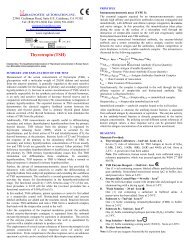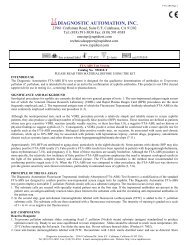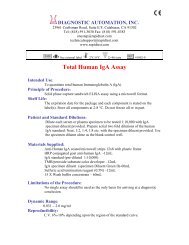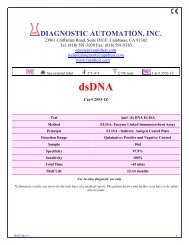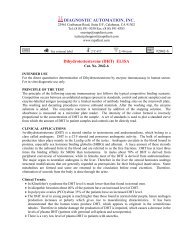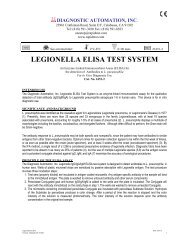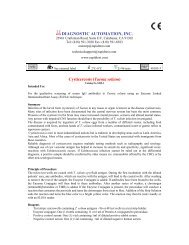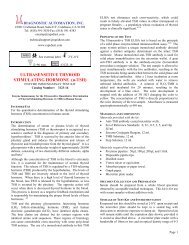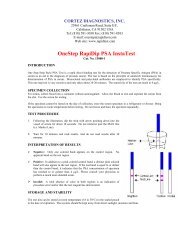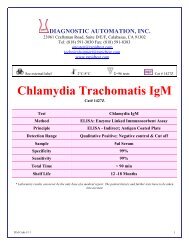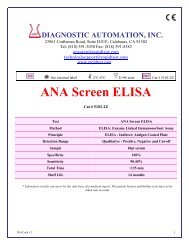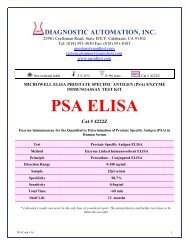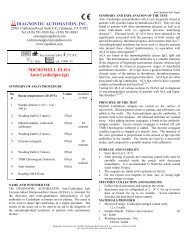HSV 1/2 IgM - Diagnostic Automation : Cortez Diagnostics
HSV 1/2 IgM - Diagnostic Automation : Cortez Diagnostics
HSV 1/2 IgM - Diagnostic Automation : Cortez Diagnostics
You also want an ePaper? Increase the reach of your titles
YUMPU automatically turns print PDFs into web optimized ePapers that Google loves.
DIAGNOSTIC AUTOMATION, INC.<br />
23961 Craftsman Road, Suite E/F, Calabasas, CA 91302<br />
Tel: (818) 591-3030 Fax: (818) 591-8383<br />
onestep@rapidtest.com<br />
technicalsupport@rapidtest.com<br />
www.rapidtest.com<br />
See external label<br />
Σ=96 tests #1444-11<br />
MICROWELL ELISA<br />
<strong>HSV</strong> 1/2 <strong>IgM</strong><br />
SUMMARY OF ASSAY PROCEDURES<br />
1. Sample dilution 1:40<br />
5 l / 200 l<br />
2. Three incubations at room temperature<br />
Diluted Sample<br />
100 ul<br />
Enzyme<br />
Conjugate<br />
100 ul<br />
2°C-8°C<br />
Substrate +<br />
Chromogen<br />
100 ul + 100 ul<br />
30 min 30 min 30 min<br />
3. Stop with 50 μl of acid. Read O.D. at 450 nm<br />
NAME AND INTENDED USE<br />
The DIAGNOSTIC AUTOMATION, <strong>HSV</strong> 1/2 <strong>IgM</strong> is intended for the<br />
detection of <strong>IgM</strong> antibodies to herpes simplex virus (<strong>HSV</strong>) 1 and 2.<br />
For in vitro diagnostic use.<br />
SUMMARY AND EXPLANATION OF THE TEST<br />
Herpes Simplex Virus is a common pathogen and its primary infection<br />
is usually asymptomatic. There are two immunologically distinct types<br />
of <strong>HSV</strong>: Type 1 and Type 2. <strong>HSV</strong> 1 is generally associated with oral<br />
infection and lesions above the waist, and <strong>HSV</strong> 2 is associated with<br />
genital infections and lesions below the waist. Clinical cases primarily<br />
are 1) eczema herpeticum with eczematous skin changes with numerous<br />
lesions, 2) Gingivo-stomatitis, and 3) Herpes sepsis, almost only found<br />
in newly born of premature infants. DIAGNOSTIC AUTOMATION<br />
<strong>HSV</strong> 1/2 <strong>IgM</strong> is an accurate serologic method to detect <strong>HSV</strong> specific<br />
antibody <strong>IgM</strong> in serum sample.<br />
PRINCIPLE OF THE TEST<br />
Purified <strong>HSV</strong> 1/2 antigen is coated on the surface of microwells.<br />
Diluted patient serum is added to wells, and the <strong>HSV</strong> <strong>IgM</strong> specific<br />
antibody, if present, binds to the antigen. All unbound materials are<br />
<strong>HSV</strong>1,2 <strong>IgM</strong> , Page 1<br />
washed away. After adding enzyme conjugate, it binds to the antibodyantigen<br />
complex. Excess enzyme conjugate is washed off and substrate<br />
and chromogen are added. The enzyme conjugate catalytic reaction is<br />
stopped at a specific time. The intensity of the color generated is<br />
proportional to the amount of <strong>IgM</strong> specific antibody in the sample. The<br />
results are read by a microwell reader compared in a parallel manner<br />
with calibrator and controls.<br />
MATERIALS PROVIDED<br />
1. Microwell Strips: purified <strong>HSV</strong> 1/2 antigen coated wells (12 x 8<br />
wells)<br />
2. Absorbent Solution: Blue Cap. I bottle (22 ml)<br />
3. Washing Concentrate: 1 bottle (100 ml, 10 x)<br />
4. Solution A: Substrate; buffer solution containing H 2 O 2 ; 1 vial (12<br />
ml)<br />
5. Solution B: Chromogen, Tetramethylbenzidine; 1 vial (12<br />
ml)<br />
6. Solution C: Enzyme Conjugate; Red color solution. 1 vial (12<br />
ml)<br />
7. Cut-off Calibrator: Yellow Cap. <strong>HSV</strong> 1/2 M Index = 1.0 (150<br />
l/vial)<br />
8. Negative Control: Range stated on label. Natural Cap. (150<br />
l/vial)<br />
9. Positive Control: Range stated on label. Red Cap. (150<br />
l/vial)<br />
10. Stop Solution: 2 N HCl; 1 vial (10 ml)<br />
11. Well Holder: 1 holder for securing strips<br />
STORAGE AND STABILITY<br />
1. Store the kit at 2 - 8 o C.<br />
2. Keep microwells sealed in a dry bag with desiccants.<br />
3. The reagents are stable until expiration of the kit.<br />
4. Do not expose test reagents to heat, sun or strong light during<br />
storage or usage.<br />
WARNINGS AND PRECAUTIONS<br />
1. Potential biohazardous materials:<br />
The calibrator and controls contain human source components which<br />
have been tested and found nonreactive for hepatitis B surface<br />
antigen as well as HIV antibody with FDA licensed reagents.<br />
However, as there is no test method that can offer complete<br />
assurance that HIV, Hepatitis B virus or other infectious agents are<br />
absent, these reagents should be handled at the Biosafety Level 2, as<br />
recommended in the Centers for Disease Control/National Institutes<br />
of Health manual, "Biosafety in Microbiological and Biomedical<br />
Laboratories." 1984<br />
2. This test kit is designed for in vitro diagnostic use only.<br />
3. Do not pipette by mouth. Do not smoke, eat, or drink in the areas in<br />
which specimens or kit reagents are handled.<br />
4. The components in this kit are intended for use as a integral unit.<br />
The components of different lots should not be mixed.<br />
5. This product contains components preserved with sodium azide.<br />
Sodium azide may react with lead and copper plumbing to form<br />
explosive metal azide. On disposal, flush with a large volume of<br />
water.<br />
<strong>Diagnostic</strong> <strong>Automation</strong>, Inc. • 23961 Craftsman Road, Suite E/F • Calabasas, California 91302<br />
Tel: (818) 591-3030, Fax: (818) 591-8383
SPECIMEN COLLECTION AND HANDLING<br />
1. Collect blood specimens and separate the serum.<br />
2. Specimens may be refrigerated at 2 - 8 o C for up to seven days or<br />
frozen for up to six months. Avoid repetitive freezing and thawing<br />
of serum sample.<br />
PREPARATION FOR ASSAY<br />
1. Prepare 1x washing buffer.<br />
Prepare washing buffer by adding distilled or deionized water to 10<br />
x wash concentrate to a final volume of 1 liter.<br />
2. Bring all specimens and kit reagents to room temperature (20-25 o C)<br />
and gently mix.<br />
ASSAY PROCEDURE<br />
<strong>HSV</strong>1,2 <strong>IgM</strong> , Page 2<br />
1. The O.D. value of the reagent blank against air from a microwell<br />
reader should be less than 0.250.<br />
2. If the O.D. value of the Calibrator is lower than 0.250, the test is<br />
not valid and must be repeated.<br />
3. The <strong>HSV</strong> 1/2 M Index for Negative and Positive Control should be<br />
in the range stated on the labels.<br />
INTERPRETATION<br />
Negative:<br />
Equivocal:<br />
Positive:<br />
<strong>HSV</strong> 1/2 M Index less than 0.90 are negative for<br />
<strong>IgM</strong> antibody to <strong>HSV</strong> 1/2.<br />
<strong>HSV</strong> 1/2 M Index between 0.91-0.99 is equivocal.<br />
Sample should be retested.<br />
<strong>HSV</strong> 1/2 M Index of 1.00 or greater are positive for<br />
<strong>IgM</strong> antibody to <strong>HSV</strong> 1/2.<br />
1. Place the desired number of coated strips into the holder.<br />
2. Prepare 1:40 dilution of test samples, negative control, positive<br />
control, and calibrator by adding 5 l of the sample to 200 l of<br />
absorbent solution. Mix well.<br />
3. Dispense 100 l of diluted sera, calibrator, and controls into the<br />
appropriate wells. For the reagent blank, dispense 100 l absorbent<br />
solution in 1A well position. Tap the holder to remove air bubbles<br />
from the liquid and mix well. Incubate for 30 minutes at room<br />
temperature.<br />
4. Remove liquid from all wells and repeat washing five times with<br />
washing buffer.<br />
5. Dispense 100 l of enzyme conjugate to each well and incubate for<br />
30 minutes at room temperature.<br />
6. Remove enzyme conjugate from all wells. Repeat washing five<br />
times with washing buffer.<br />
7. Dispense 100 l of solution A and 100 l of solution B and<br />
incubate for 30 minutes at room temperature.<br />
8. Add 50 l of 2 N HCl to stop reaction.<br />
Make sure there are no air bubbles in each well before reading<br />
9. Read O.D. at 450 nm with a microwell reader.<br />
CALCULATION OF RESULTS<br />
1. Calculate the mean of duplicate calibrator value x c .<br />
2. Calculate the mean of duplicate positive control, negative control<br />
and patient samples.<br />
3. Calculate the <strong>HSV</strong> 1/2 M Index of each determination by dividing<br />
the mean values of each sample by calibrator mean value, x c .<br />
Example of typical results:<br />
Cut- off Calibrator <strong>HSV</strong> 1/2 M Index = 1.0<br />
Cut-off Calibrator O.D. = 0.358, 0.365 x c = 0.362<br />
Negative control O.D. = 0.158, 0.162 x n = 0.160<br />
<strong>HSV</strong> M Index = 0.160 / 0.362 = 0.44<br />
Positive control O.D. = 1.305, 1.346 x p = 1.326<br />
<strong>HSV</strong> M Index = 1.326 / 0.362 = 3.66<br />
Patient sample O.D. = 1.409, 1.459 x s = 1.434<br />
<strong>HSV</strong> M Index = 1.434 / 0.362 = 3.96<br />
QUALITY CONTROL<br />
The test run may be considered valid provided the following criteria are<br />
met:<br />
PERFORMANCE CHARACTERISTICS<br />
Precision:<br />
<strong>Diagnostic</strong> <strong>Automation</strong>, Inc. • 23961 Craftsman Road, Suite E/F • Calabasas, California 91302<br />
Tel: (818) 591-3030, Fax: (818) 591-8383<br />
The precision of the assay was evaluated by testing three different sera<br />
of eight replicates over a period of one week.<br />
The intra-assay and inter-assay C.V. are summarized below:<br />
Negative Low positive Positive<br />
Intra-assay 8.2% 7.2% 6.3%<br />
Inter-assay 9.1% 8.2% 6.5%<br />
LIMITATION OF THE PROCEDURE<br />
1. To prevent false negative and false positive <strong>IgM</strong> test results caused<br />
by the presence of specific IgG and rheumatoid factor (RF) in some<br />
specimens, reagents provided in this kit has been formulated to<br />
resolve these interferences. However, specimens with extremely<br />
high RF and high autoimmune antibodies, the possibility of these<br />
interferences cannot be ruled out entirely.<br />
2. As with other serological assays, the results of these assays should<br />
be used in conjunction with information available from clinical<br />
evaluation and other diagnostic procedures.<br />
3. A negative serological test does not exclude the possibility of past<br />
infection. Following primary <strong>HSV</strong> infection, antibody may fall to<br />
undetectable levels and then be boosted by later clinical infection<br />
with the same or heterologous type. Such a phenomenon may lead<br />
to incorrect interpretations of seroconversion and primary infection,<br />
or negative antibody status. In addition, samples obtained too early<br />
during primary infection may not contain detectable antibody.<br />
Some persons may fail to develop detectable antibody after Herpes<br />
infection.<br />
REFERENCES<br />
1. Nahmias, A.J., J. Dannenbarger, C. Wickliffe and M. Muther.<br />
Clinical aspects of infection with herpes simplex viruses 1 and 2 in<br />
the human herpes viruses. An interdisciplinary Perspective<br />
(Nahmias, A.J., W.R. Dawdle and R.F. Schinazi eds) New York,<br />
Elsevier, pp 3-9, 1981.<br />
2. Vestergaard, B.F., P.C. Grauballe and H. Spanggaard. Titration of<br />
herpes simplex virus antibodies in human sera by the enzyme-link<br />
immunosorbent assay (ELISA). Acta Pathol. Microbiol. Scand.<br />
Sect. B 85:446-448, 1977.
3. Coleman, R.M., L. Pereira, P.D. Bailey, D. Dondero, C. Wickliffe,<br />
and A.J. Nahmias. Determination of herpes simplex virus typespecific<br />
antibodies by enzyme-linked immunosorbent assay. J.<br />
Clin. Microbiol. 18(1983) 287<br />
<strong>HSV</strong>1,2 <strong>IgM</strong> , Page 3<br />
DIAGNOSTIC AUTOMATION, INC.<br />
23961 Craftsman Road, Suite E/F, Calabasas, CA 91302<br />
Tel: (818) 591-3030 Fax: (818) 591-8383<br />
ISO 13485-2003<br />
Revision Date: 3/27/06<br />
<strong>Diagnostic</strong> <strong>Automation</strong>, Inc. • 23961 Craftsman Road, Suite E/F • Calabasas, California 91302<br />
Tel: (818) 591-3030, Fax: (818) 591-8383



